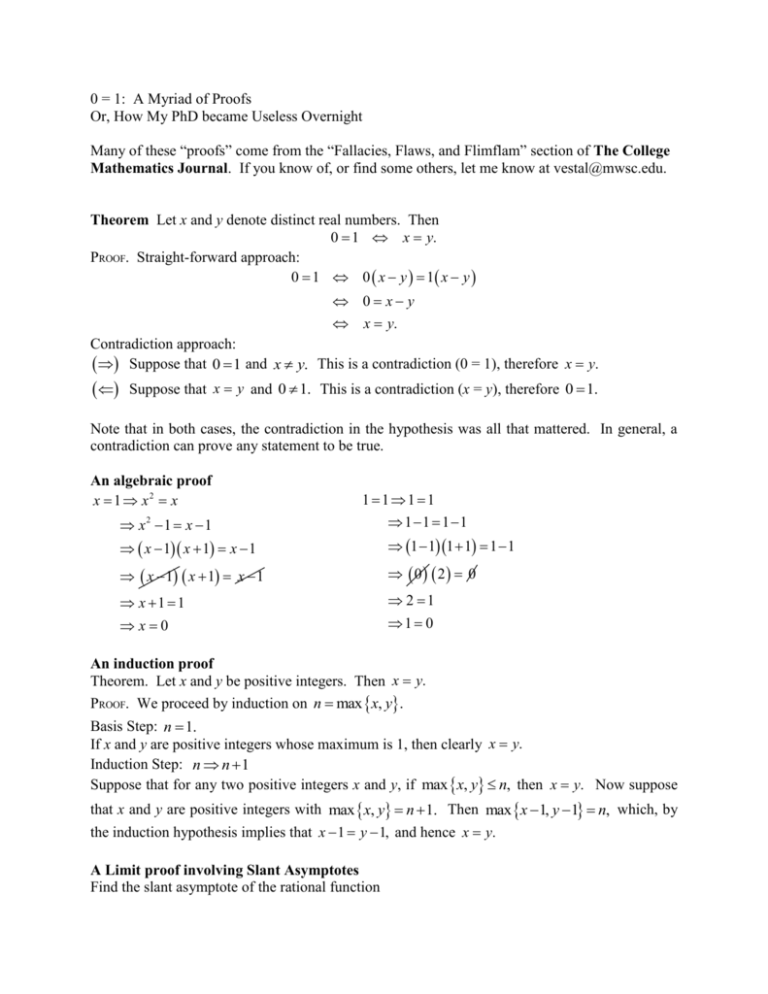A Collection of Proofs
advertisement

0 = 1: A Myriad of Proofs Or, How My PhD became Useless Overnight Many of these “proofs” come from the “Fallacies, Flaws, and Flimflam” section of The College Mathematics Journal. If you know of, or find some others, let me know at vestal@mwsc.edu. Theorem Let x and y denote distinct real numbers. Then 0 1 x y. PROOF. Straight-forward approach: 0 1 0 x y 1 x y 0 x y x y. Contradiction approach: Suppose that 0 1 and x y. This is a contradiction (0 = 1), therefore x y. Suppose that x y and 0 1. This is a contradiction (x = y), therefore 0 1. Note that in both cases, the contradiction in the hypothesis was all that mattered. In general, a contradiction can prove any statement to be true. An algebraic proof x 1 x2 x x2 1 x 1 1111 1 1 1 1 x 1 x 1 x 1 1 11 1 1 1 x 1 x 1 x 1 0 2 0 x 1 1 2 1 x0 1 0 An induction proof Theorem. Let x and y be positive integers. Then x y. PROOF. We proceed by induction on n max x, y. Basis Step: n 1. If x and y are positive integers whose maximum is 1, then clearly x y. Induction Step: n n 1 Suppose that for any two positive integers x and y, if max x, y n, then x y. Now suppose that x and y are positive integers with max x, y n 1. Then max x 1, y 1 n, which, by the induction hypothesis implies that x 1 y 1, and hence x y. A Limit proof involving Slant Asymptotes Find the slant asymptote of the rational function y x2 2 x 2 . x 1 Using long division, we get x2 2 x 2 x2 2 x 1 1 x2 2 x 1 1 1 x 1 , x 1 x 1 x 1 x 1 x 1 and thus the oblique asymptote is y x 1. On the other hand, dividing by x yields x2 2x 2 x 2 2 / x , x 1 1 1/ x and letting x , this becomes x2 , 1 so that the oblique asymptote is y x 2. This implies that 1 2. A Calculus proof involving derivatives Since x2 x x x, x times it follows that d 2 d x x x x , dx dx x times i.e. 2 x 1 1 1 x. x times Since this is true for all x, it is true for x 1, and therefore 2 1. A Calculus proof involving integration 1 Consider dx. Using integration by parts with x 1 u dv dx x 1 du 2 dx v x x yields 1 x 1 x dx 1 x 2 dx 1 x dx and thus 0 1. A Calculus proof involving definite integrals We evaluate sin 2 x dx in two ways. 0 1: 1 cos 2 x x cos 2 x dx 2 2 4 0 2 sin x dx 0 x x 0 2 Using the substitution u sin x, we get du cos x dx 1 sin 2 x dx, du du dx . Thus the integral becomes 1 sin 2 x 1 u2 0 u 2 du 2 sin x dx 0 0 1 u 2 0. Therefore 0. 2 2: so that A Calculus proof involving Series Using the Taylor series for the natural logarithm x 2 x3 x 4 ln 1 x x , 2 3 4 with x 1, we get 1 1 1 1 1 1 1 1 1 1 1 ln 2 1 2 3 4 5 6 7 8 9 10 11 12 1 1 1 1 1 1 1 1 1 1 1 2 4 3 6 8 5 10 12 7 14 1 1 1 1 1 1 1 1 1 1 1 2 4 3 6 8 5 10 12 7 14 1 1 1 1 1 1 1 2 4 6 8 10 12 14 1 1 1 1 1 1 1 1 1 1 1 1 1 2 2 3 4 5 6 7 8 9 10 11 12 1 ln 2. 2 The only number equal to half of itself is zero, thus ln 2 0. A Linear Algebra proof Choose a positive integer n and let S be the set of all real solutions x1 , x2 , , xn , xn1 to the equation x1 x2 xn xn1 1. (*) Since any choice of x1 , x2 , , xn uniquely determines the value of xn 1 , the mapping f : Rn1 Rn defined by f x1 , x2 , , xn , xn1 x1 , x2 , , xn maps S one-to-one onto R n . Moreover, f preserves addition and scalar multiplication, so that S is in fact isomorphic to R n . Therefore, S must be a vector space, and thus contains the zero vector 0,0, ,0 . But if this zero vector satisfies (*), then 0 must equal 1. A Complex Analysis proof Picard’s Theorem: If f z is a nonconstant, entire function (differentiable everywhere), then f takes on every complex value with the possible exception of one complex number. For example, the function f z e z takes on every complex value except for 0. Theorem. 0 1 z PROOF. Applying Picard’s Theorem to the nonconstant, analytic function f z ee , this function takes on all complex values, with at most one exception. z ee 0 : This is impossible, because e to any power can never be zero. ee 1: This is impossible, because ee 1 e z 0. Therefore, 0 1. z z A Physics Proof (with some trigonometry) Suppose that we have a stick one foot long leaning against a wall. Find the angle which will maximize the value of x 2 y. Using x cos and y sin , we maximize cos 2 sin to obtain / 6. Repeating the problem using 12 inches, we have x 12cos and y 12sin , and the maximum of 144 cos 2 12sin occurs when sin 1/ 24, which is not / 6. Therefore, one foot does not equal 12 inches. 1 foot = 12 inches y x A Proof involving exponents x 2. x 2, it follows that x 2 2, and thus x 2. On the other hand, consider the equation Solve x x From x x yy y 4. As before, we get yy This gives us 2 2 2 2 4. y 4 y4 4 y 2.








